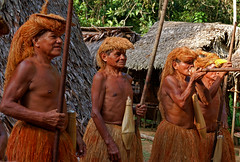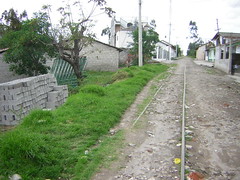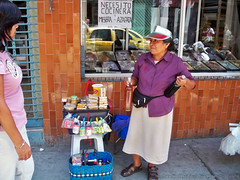In November, Tom Filipowicz visited the event held for the Mochica Identity Week and discusses what he feels is a strong local connection and respect for traditions and customs. Participating were school groups, each choosing and important local custom to present to visitors.
Category: "Lambayeque & Chiclayo Guide"
The Village of Cura Mori
Cora Mori is a small desert community located twenty miles south of Piura. Maribel’s uncle Manuel and aunt Laura live here. I like to visit because the contrast between Cura Mori and Chiclayo is vast. The only sounds you’ll hear are from the livestock and occasionally children’s voices.
Tourism and the Town of Pimentel
Here in the north tourist towns are not numerous. To the south of Chiclayo is Huanchaco beach near Trujillo, a distance of 250 miles. North of Chiclayo is Máncora and Punta Sal, a distance of some 200 miles. In our immediate area we’re limited to Pimentel.
Naylamp’s temple discovered in Lambayeque
After eight months of careful excavation, archaeologists of the Brüning Museum in Lambayeque have discovered, next to the Huaca Chornancap pyramid, what is thought to be the sacred temple of Naylamp, a supposedly mythical ruler that according to oral legend was the founder of the post-Moche Lambayeque civilisation.
Youngest Moche noble yet at Sipán site
Two thousand years ago, a young man was buried in the royal mausoleum next to a huge and brightly decorated Moche pyramid, now known as the Huaca Rajada, at the site of Sipán. Studies have been conducted on this recent discovery that have determined his age at time of death to be just 21, making him the youngest Moche noble yet found.
Wari city unveiled in Cerro Pátapo – missing link discovered
In less than two weeks since work began, amazing discoveries have been made at the Cerro Pátapo archaeological site, until now little more than a pile of rocks. This huge site that stretches over 5km is now revealing its importance – it is a missing link between the declining Moche culture and the newly arrived Wari.
Ferreñafe
This small town, 18km from Chiclayo is known as the land of two faiths: Shamanism and Catholicism. How they so easily go hand in hand, I’ll let you figure out – but this is a common occurrence across all of Latin America. The town was founded in 1550 in its full name Santa Lucía de Ferreñafe, in a region with history more ancient still. This is shown when you enter town by an arch with Sicán adornments which if passed under eventually leads to the plaza, with its 150 year old Spanish fountain, and the Santa Lucía Church.
Chaparrí
Created when the people of Santa Catalina realised there was value in the preservation of natural habitats, and thanks to the work of Peruvian photographer Heinz Plenge, this huge reserve in Chongoyape, 60km from Chiclayo, is part of one of the largest remaining dry forests in the world.
Zaña that was
Competing with the Bosque de Pomac, in my opinion, as the most interesting place in Lambayeque are the ruins of Zaña. Refreshingly, these ruins are of a different kind to the ones you might be used to seeing while visiting Peru.
Túcume
The Sicán abandoned the old center of their civilisation at Batán Grande and relocated to the current site of Túcume. Built entirely of adobe mud bricks between 1000-1100 AD, the site flourished for nearly a milenia under Sicán, Chimú and Inca rule until the arrival of the Spanish in 1532. Spread over more than 220 hectares, there are 26 enormous pyramids standing in ruins.
Batán Grande – Bosque de Pomac
This incredible place is as interesting as it is beautiful. Baked in hot sun, cut in half by a river that floods the area in the rainy season and dotted with ancient pyramids, this dry forest of algarrobo trees on the old grounds of the Batán Grande suger-cane hacienda was the highlight of my time in Lambayeque.
Museo Nacional Sicán
The museum gets a special mention, not only because like all museums in northern Peru it shames the rest of the country, but also it allowed you to take photos of the artefacts unlike the Sipán museum, also unbelievably excellent.
The Sicán of course, are the pyramid builders who left us Batán Grande and Túcume. This museum exists to display the most important finds of the tonnes uncovered.










![Part 3: A visit to the men’s prison in San Juan de Lurigancho [Featured]](http://farm4.static.flickr.com/3625/3395439630_49fd35692a_m.jpg)